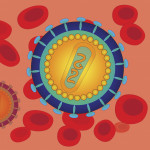People with HIV who aren’t also infected with viral hepatitis are at significant risk of developing liver disease, but long-term consistent use of antiretroviral (ARV) therapy appears to be protective, according to a study published in the May 9 issue of Clinical Infectious Diseases.
Liver disease is now the No. 1 cause of death in people with HIV. While the vast majority of people with HIV who have liver disease are also infected with either hepatitis C virus (HCV) or hepatitis B virus (HBV), people with HIV who don’t have hepatitis are also at significantly increased risk for liver failure.
Two of the challenges of monitoring for liver disease in people who don’t otherwise have major risk factors are predicting who is most at risk and determining the best method to monitor for the disease. The gold standard for assessing a person’s liver condition is a liver biopsy, but that can be quite painful and it carries some health risks—plus, most providers would not perform a biopsy on someone who doesn’t have risks or signs of liver disease.
To help determine the risk of liver disease progression, and to validate the use of non-invasive methods for monitoring liver disease, Monia Mendeni, MD, from the University of Brescia School of Medicine, in Brescia, Italy, and her colleagues followed 1,112 HIV-positive people enrolled in the Italian Hepatotoxicity of Different Kinds of Antiretrovirals study.
To be eligible for the analysis, people needed to have enrolled in the study between 1996 and 2006. They also could not have either HBV or HCV, and they could not have been diagnosed with cirrhosis. The average length of follow-up in the study was six years. More than two thirds of the study participants were male, and the average age was 36. The majority of the participants did not have liver damage (fibrosis) at the beginning of the study.
Mendeni’s team used two methods for assessing the conditions of the participants’ livers. One is called an FIB-4 score, which is based on a calculation of a person’s age, alanine transaminase (ALT) levels and the ratio of aspartate transaminase (AST) levels to platelet count. A second method, called APRI, calculates only the AST to platelet ratio.
The team found that liver fibrosis progression was common, even in the absence of viral hepatitis. Using the FIB-4 scoring method, 259 (24 percent) of the participants progressed to a greater degree of liver fibrosis over the course of the study, with 89 of them being confirmed by liver biopsy to have fibrosis. Using the APRI scoring, 356 (31 percent) people had progression of liver fibrosis, which was confirmed by biopsy in 126 of them. Regardless of the scoring method, most people who initially showed progression reverted back to a healthier score without any sort of treatment intervention.
Mendeni and her colleagues found that the FIB-4 and the APRI scoring methods differed in their predictive value, particularly in people with the mildest fibrosis. Both methods, however, had a much higher degree of accuracy when predicting fibrosis in people with more advanced liver disease.
Overall, the team found that older age increased the likelihood of having liver fibrosis more than any other factor. Having a low CD4 count also increased the chance of having liver disease progression.
Of note, Mendeni’s team found—for the first time in any study—that longer-term use of ARV medication had a protective affect against liver disease progression. The effect was small, but present. The team also found that people who took Videx (didanosine), Zerit (stavudine) or Hivid (zalcitabine) were more likely to have fibrosis progression, confirming previous studies showing that these drugs may have a negative impact on the liver.
The authors acknowledge that FIB-4 and APRI are not gold-standard methods for assessing liver fibrosis, and thus may not have provided the most accurate measure of liver damage. They note, however, that performing proactive liver biopsies in people without significant risk factors is unethical. They also acknowledge that excessive alcohol use might also have influenced the study results, but point out that they tried to control for this by measuring gamma-GT levels.
“This study demonstrated that HIV-[positive people who aren’t also infected with HCV or HBV] display significant risk of [liver fibrosis] liv liver progression,” state the authors. “Although formal validations are necessary, in the meantime, FIB-4 and APRI should be used to identify those patients who are most at risk and who need further clinical work-up (such as liver biopsy) and more-proactive counseling to modify dangerous behaviors (such as alcohol abuse).”
“Lastly,” they conclude, “our results suggest the benefit of earlier [ARV] initiation for liver disease fibrosis in HIV-monoinfected patients, provided that the most dangerous drugs [e.g. Zerit, Videx and Hivid] are avoided.”
Advertisement
Advertisement
Advertisement






2 Comments
2 Comments